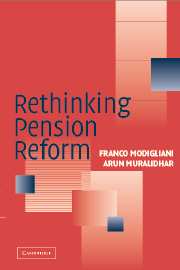Book contents
- Frontmatter
- Contents
- Preface
- Acknowledgments
- A Tribute to Franco
- Rethinking Pension Reform
- 1 A Primer on Pension Reform
- 2 A Taxonomy of Pension Reform Issues
- 3 An Evaluation of Pension Reforms
- 4 Welfare Costs of Defined Contribution Schemes
- 5 The Transition from PAYGO to Funding with a Common Portfolio: Application to the United States
- 6 Social Security Reform in Spain
- 7 The “Two-Pension Fund” Theorem
- 8 The Case for Mixed Systems and Variable Contributions: Improving the Performance of Pension Systems
- References
- Index
1 - A Primer on Pension Reform
Published online by Cambridge University Press: 22 August 2009
- Frontmatter
- Contents
- Preface
- Acknowledgments
- A Tribute to Franco
- Rethinking Pension Reform
- 1 A Primer on Pension Reform
- 2 A Taxonomy of Pension Reform Issues
- 3 An Evaluation of Pension Reforms
- 4 Welfare Costs of Defined Contribution Schemes
- 5 The Transition from PAYGO to Funding with a Common Portfolio: Application to the United States
- 6 Social Security Reform in Spain
- 7 The “Two-Pension Fund” Theorem
- 8 The Case for Mixed Systems and Variable Contributions: Improving the Performance of Pension Systems
- References
- Index
Summary
DEFINITION OF TERMS
Pension reform evokes certain primary questions: What is a pension system? Why must it exist? And, what does the balance sheet of a pension system look like? The primary purpose of a pension system is to help households achieve an allocation of life resources by smoothing consumption over life, as postulated in the life-cycle hypothesis (LCH). This is achieved by transferring resources from working life to postretirement, when income dries up. Before debating the appropriate form of pension plan, it is worthwhile to record the reasons for the existence of pension plans. There is a plethora of literature on the subject, and researchers have undertaken a wide range of empirical studies (World Bank 1994). For example, Logue and Rader (1997) have suggested that, from a corporate perspective, plans must be set up for insurance against uncertainty about retirement income, to create recruitment and retention incentives, and to formulate a tax-efficient means of saving. These conclusions may be restated under three main headings for country and corporate plans.
First, redistribution and social insurance are particularly valid for public systems. This is equivalent to undertaking a social obligation to ensure that all citizens, especially the old, have the requisite resources to meet their basic needs. However, the primary reason for the state to provide this arrangement is the belief that many citizens are myopic and do not accumulate adequate resources for retirement (Samuelson 1975, Aaron and Reischauer 1998).
- Type
- Chapter
- Information
- Rethinking Pension Reform , pp. 1 - 16Publisher: Cambridge University PressPrint publication year: 2004



